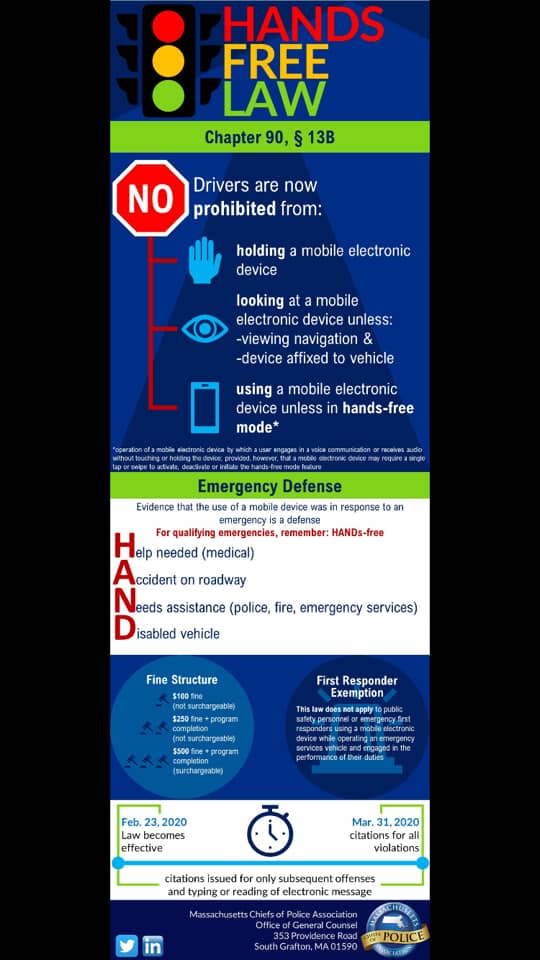The following is a media release from the Governor’s office submitted to SOURCE media.
***
[broadstreet zone=”51611″]
BOSTON – Today, February 20, Baker-Polito Administration issued a reminder to motorists that the hands-free law goes into effect this Sunday, February 23rd. Signed by Governor Charlie Baker in November, the new law is intended to reduce the number of people injured or killed because of distracted driving, and levies penalties that will be enforced by local and state police.
“Our administration is committed to keeping Massachusetts roads safe, and we urge all drivers to pay attention when they are behind the wheel,” said Governor Charlie Baker. “This law holds drivers accountable for keeping their focus on the road while being aware of the vehicles, pedestrians and bicyclists around them and we are pleased that it will take effect this week.”
The new law, An Act requiring the hands-free use of mobile telephones while driving, stipulates that operators of motor vehicles cannot use an electronic device unless the device is being used in hands-free mode.
[broadstreet zone=”52093″]
Operators cannot read or view text, images or videos, unless what is being viewed is helping with navigation, and the device is mounted in an appropriate location.
Motorists also cannot make phone calls unless they can do so without holding their phones, by utilizing technology such as Bluetooth.
The law also requires law enforcement officers to report data on violations that will be shared with the public.
The use of phones and all electronic devices, including phones in hands-free mode, remains illegal for drivers under the age of 18.
[broadstreet zone=”58610″]
“The hands-free law will help increase road safety for all users, including pedestrians and bicyclists, who have the fastest growing rate of crashes caused by inattentive drivers,” said Lt. Governor Karyn Polito. “If you are behind the wheel, your attention should be on the road.”
“Nothing you text, watch, or search for on your device is more important than your safety, the safety of your passengers, and everyone on the road around you,” said Secretary of Public Safety and Security Thomas Turco. “Even when you’re stopped at a traffic light, you need to put your device away and focus on the road.”
Punishment for violating the hands-free law includes a $100 fine for a first offense, a $250 fine for a second offense, and a $500 fine for a third or subsequent offense.
Operators who commit a second or subsequent offense are required to complete an educational program focused on distracted driving prevention.
A third or subsequent offense will count as a surchargeable incident.
[broadstreet zone=”70107″]
“Today is an important day for everyone who uses roads across the Commonwealth,” said Transportation Secretary and CEO Stephanie Pollack. “MassDOT thanks the Baker-Polito Administration, transportation experts, advocacy groups and victims’ families who pushed for this law because they know how dangerous distracted drivers are to everyone around them. We look forward to continue working with our partners to make Massachusetts roadways safe.”
“Every driver has a responsibility to operate their vehicle safely,” said Acting Registrar of Motor Vehicles Jamey Tesler. “Elevating distracted driving to a fineable offense with potential insurance surcharges sends a clear message to motorists that it is dangerous and will not be tolerated.”

“The Massachusetts State Police and local police departments will roll extra patrols to kick off enforcement of the Hands-Free law,” said Colonel Christopher S. Mason, Superintendent of the Massachusetts State Police. “But our hope is that all drivers will comply with this important law and keep their eyes on the road and their hands on the wheel. There is nothing on your screen that is worth your life or the life of another.”
Traffic safety experts believe driver inattention is a contributing factor in the following trends: Between 2012 and 2017, nearly 20,000 people died in crashes involving a distracted driver in the United States. 9.5% of all fatal crashes in this time frame involved a distracted driver (NHTSA).
[broadstreet zone=”59948″]
Total traffic fatalities in Massachusetts increased 12.8% (345 to 389) from 2015 to 2016, more than double the national rate of increase of 5.6% (FARS).
Between 2014 and 2018, 233 people in Massachusetts died in crashes involving a distracted driver
In Massachusetts, annual crashes involving a distracted driver have risen 35.7% from 28 in 2014 to 38 in 2018.
Distracted crashes in which a driver was “manually operating an electronic device” rose 70% from 2014 to 2016.

Distracted driving crashes resulting in injury have increased by nearly 170% from 2014 to 2016.78 pedestrians were killed in Massachusetts in 2018; this represents an increase of 8.3% from 2017 (FARS).17% of children 14 and younger killed in traffic crashes in 2018 were pedestrians (NHTSA).
Under the new law, vehicles without built-in GPS, Apple Car Play, or Android Audio must be equipped with a phone mount on the dash or windshield for GPS navigation.
Acceptable options to equip your vehicle for hands-free phone use are listed below.
For vehicles with Bluetooth, a phone mount is all that is needed for GPS navigation.
All phone communication can be routed through the Bluetooth connection.
For vehicles with an Aux port but no Bluetooth, operators can purchase a Bluetooth adapter that plugs into their vehicle’s cigarette lighter and includes a cable for connecting to the Aux port for phone audio. Some include microphones and a dash-mountable button to answer calls, while some others rely on the phone’s microphone.
For vehicles without Bluetooth or an Aux port, the following options are acceptable: Standalone hands-free device with built-in Bluetooth, speaker and microphoneBluetooth adapter with FM transmitter to use car speakers for audio Single-ear earpiece that can connect to phone via BluetoothReplacement head unit that includes either Apple CarPlay, Android Audio, or Bluetooth (must be professionally installed)
To fully comply with the law while using any of these options, the use of a voice assistant on the phone or through the car’s infotainment system is required. Apple’s Siri or Google Assistant must be enabled and used to issue commands to place calls, and listen to and respond to text messages.
For motorists not using hands-free technology, the EOPSS Office of Grants and Research offers these additional tips:
Before driving, please turn your phone off and put it out of reach.
Set your mobile phone to “Do Not Disturb While Driving” mode.
Let your friends and family know that you’ll be driving and can’t take their calls or texts.
If you have to make a call or send a text, pull over.
Watch for pedestrians and bicyclists – especially at night.
Remember to buckle up! Seatbelts are your best defense against a distracted driver.

